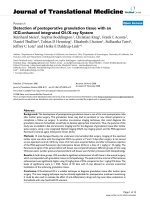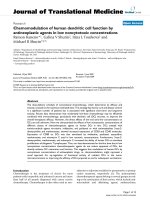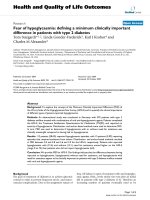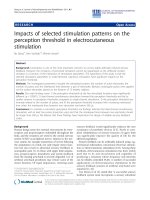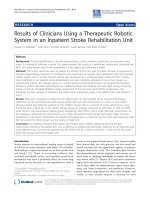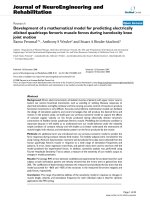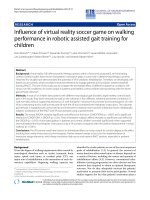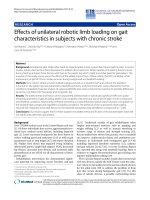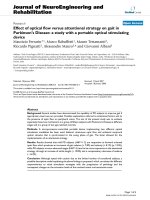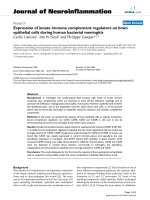báo cáo hóa học: " Results of five-year systematic screening for latent tuberculosis infection in healthcare workers in Portugal" docx
Bạn đang xem bản rút gọn của tài liệu. Xem và tải ngay bản đầy đủ của tài liệu tại đây (318.35 KB, 7 trang )
RESEARC H Open Access
Results of five-year systematic screening for
latent tuberculosis infection in healthcare workers
in Portugal
José Torres Costa
1,2,3*
, Rui Silva
1,2,3
, Raul Sá
1
, Maria João Cardoso
4
, Albert Nienhaus
5
Abstract
Introduction: The risk of tuberculosis (TB) in healthcare workers (HCWs) is related to its incidence in the general
population, and increased by the specific risk as a professional group. The prevalence of latent tuberculosis
infection (LTBI) in HCWs in Portugal using the tuberculin skin test (TST) and the interferon-g release assays (IGRA)
was analyzed over a five-year period.
Methods: A screening prog ramme for LTBI in HCWs was conducted, with clinical evaluations, TST, IGRA, and chest
radiography. Putative risk factors for LTBI were assessed by a standardised questionnaire.
Results: Between September 2005 and June 2009, 5,414 HCWs were screened. The prevalence of LTBI was 55.2%
and 25.9% using a TST ≥ 10 mm or an IGRA test result (QuantiFERON-TB Gold In-Tube) INF-g ≥0.35 IU/mL as a
criterion for LTBI, respectively. In 53 HCWs active TB was diagnosed. The number of HCWs with newly detected
active TB decreased from 19 in the first year to 6 in 2008. Risk assessment was poorly related to TST diameter.
However, physicians (1.7%) and nurses (1.0%) had the highest rates of active TB.
Conclusions: LTBI and TB burden among HCWs in Portugal is high. The screening of these profe ssionals to identify
HCWs with LTBI is essential in order to offer preventive chemotherapy to those with a high ris k of future
progression to disease. Systemati c screening had a positive impact on the rate of active TB in HCWs either by early
case detection or by increasing the awareness of HCWs and therefore the precautions taken by them.
Introduction
With the advent of antibiotics, many infectious diseases
such as tuberculosis (TB) seemed well under control [1].
This feeling of security led to an absence of investment
in implementing preventive measures and of training
and education for healthcare workers (HCWs) on the
risk of nosocomial inf ections and occupationa l diseases
[2]. The emergence of groups with epidemic TB infec-
tion, i.e. HIV/AIDS-patients, further aggravated the
situation [3].
In HCWs, the risk of TB infection is increased by
exposure to patients with infectious disease, insufficient
use of protective equipment such as respirators, and
working conditions, particularly in inadequately venti-
latedareasandwhenconducting techniques which
involve exposure to contaminated aerosols [3,4]. Given
this higher risk of contracting the disease by exposure
to M. tuberculosis in the workplace, in Portugal it is
considered an occupational dis ease [5]. The incidence of
TB in HCWs is related to the incidence in the general
population in t hat geographical area. Added to this is
the specific risk as a pro fessional group, which depends
on the type of health unit, workgroup, and efficiency in
the implementation of infection control measures [6-9].
According to official records, the average rate of TB
reported in the general population in Portugal is 29.4/
100,000, which means that, despite the reduction
observed in recent years, it still has the highest inci-
dence in the EU excluding the countries of the 2004
enlargement [10]. Despite the mandatory notification of
active TB, there are no official records in Portugal of
the number of affected HCWs [11].
Early diagnosis and effective treatment of patients,
early recognition of possible contacts, the adoption of
protective measures and the effective screening for cases
* Correspondence:
1
Occupational Health Division, Hospital S. João, EPE - Porto, Portugal
Torres Costa et al. Journal of Occupational Medicine and Toxicology 2010, 5:22
/>© 2010 Costa et al; licensee BioMed Central Ltd. This is an Open Access article distributed under the terms of the Creative Comm ons
Attribution License ( y/2.0), which permits unrestricted use , distribution, and reproduction in
any med ium, provided the original work is properl y cited.
of latent tuberculosis infection (LTBI) are all necessary
for controlling the risk of TB in HCWs [9,12,13]. The
diagnosis of recent cases of LTBI (conversion) is parti-
cularly important since the lifetime risk of progression
to active disease ranges from 10 to 20% [12,14]. Accord-
ing to several studies, the treatment of LTBI reduces the
risk of developing active TB by more than 50% [15-17],
and is therefore one of the main objectives of a screen-
ing programme.
Until a few years ag o, contacts were screened for con-
versions using the tubercu lin skin test (TST) [18]. In
recent years, advance s in molecular biology have led to
the development of new in-vitro tests that measure t he
levels of interferon-g released by sensitized T lympho-
cytes after stimulation with antigens of M. tuberculosis.
These interferon-g release assays (IGRA) do not present
cross-reaction with Bacillus Calmet-Guérin (BCG), nor
with the majority of nontuberculous mycobacteria [19].
Several HCW studies using IGRA have been p erformed
so far comparing TST to IGRA [20-25]. While systema-
tic screening of HCWs for TB started in 2005 at the
S. João Hospital in Porto, Portugal, IGRA testing was
introduced to the screening process in 2007. The
subgroup in which TST and IGRA were performed
simultaneously is described in previous papers [22,23].
In this paper we describe the results of the screening
programme for the whole group that was scr eened
between 2005 an d 2009. Spe cial emphasis is placed on
workplace risk factors that might account for LTBI or
active TB in HCWs.
Methods
The risk of M. tuberculosis infection was assessed in
5,524 HCWs w orking or training in our hospital
between September 2005 and June 2009 (Figure 1).
According to the latest CDC guidelines (2005) and
based on the number o f beds and p atients diagnosed
with TB each year (average of 258 patients, and 17.2
HCWs per TB patient ratio), the hospital is classified as
a “medium risk” institution [9]. This screening was done
on a regular annual basis, whenever new staff were
employed, following occasional requests from sympto-
matic workers, or in cases of contact with infectious
patients or materials. The risk of transmission of TB
was classified as low, moderate and high, accordin g to
the CDC [9].
This screening programme consisted of: 1) a standar-
dized interview covering gender, age , workplace, expo-
sure situation, TB history and TB-related respiratory
symptoms (cough, productive cough, haemoptysis, thor-
acalgia) as well as constitutional sy mptoms (fatigue,
weigh t loss, fever and night sweat), 2) chest radiography
(CXR) if TST or IGRA were positive or if symptomatic,
3) TST with 0.1 mL of 2 units of purified tuberculin
(PPD) RT 23 SSI, unless contraindication (previous
tuberculin reaction ≥15 mm, previous diagnosis o f TB
with appropriate treatment, severe viral infection or
immunisation with vaccine with live virus less than 1
month ago, large extensive burns or eczema), and 4)
since April 2007 in-vitro enzyme immunoassay (ELISA)
test based on the quantification of interferon-g, Quanti-
FERON -TB Gold In-Tube (IGRA). This test was carried
out simultaneously with the TST [26]. A TST ≥ 10 mm
was considered as positive, in accordance with Portu-
guese guidelines [13] . IGRA tests were carried out on
the basis of the manufacture’s manual and considered
positive when ≥0.35 IU/mL. Undetermined IGRA results
were repeated once. If screening was performed as a
result of unprotected contact with infectious patients or
materials, TST and IGRA were performed eight weeks
aft er contact and CXR was performed 3 months and 12
months after contact.
Active TB was defined as infection with M. tuberculo-
sis, with or without symptoms and/or clinical signs, typi-
cal CXR and confirmed microbiologically. LTBI was
defined as infection with M. tuberculosis, without
any clinical manifestation, and was diagnosed if TST
≥ 10 mm or IGRA > 0.35 IU/mL after exclusion of
active TB regardless of CXR results due to the low sen-
sitivity and specificity of CXR for the diag nosis of LTBI.
The prevalence of LTBI when taking up employment
(first week of employment) was compared with follow-
up examinations.
Only in a subgroup were IGRA and TST performed
simultaneously. This is because IGRA testing was intro-
duced two years after the start of the systematic screen-
ing. The probability of a positive IGRA based on TST
results was calculated for this subgroup. These probabil-
ities were multiplied by the number of HCWs in the
whole study group who had the same TST results. Add-
ing up these products gave the number of HCWs that
can reasonably be expected to be IGRA-positive in the
whole group if they had all been tested with IGRA. This
allowed the prop ortion of IGRA-positive H CWs in th e
whole study group to be estimated.
Statistical analysis was performed using a two-tailed
chi-square t est to compare proportions of positive tests
(TST and IGRA) and Student´s t-test, and a simple
analysis of variance (one way ANOVA) to compare
means and standard deviations between groups. A
p-value < 0.05 was considered statistically significant.
Analysis was carried out with SPSS, Version 14.
The evaluation was carried out according to the objec-
tives of the Commission for the Prevention and Control
of Tuberculosis of Hospital S. João, no additional data
was collected, and the analysis was carried out anon-
ymously. For these reasons it was not necessary to
request approval by the Ethics Committee.
Torres Costa et al. Journal of Occupational Medicine and Toxicology 2010, 5:22
/>Page 2 of 7
Results
The study comprises 5,524 HCWs working or training
between September 2005 and June 2009 in our Hospital.
TST results are available for 5,209 H CWs (Figure 1).
Due to active TB in their medical history, TST was not
performed in 234 (4.3%) HCWs.Ofthese,33didnot
know the year of diagnosis, 88 reported that it had
occurred before working as HCW and 113 afterwards.
Based on clinical evaluation and CXR, none of these 234
HCWs had active TB at the time of screening.
32.9% of the HCWs had a TST ≥ 15 mm and 55.2%
(32.9%+22.3%) had a TST ≥ 10 mm (Table 1). BCG vac-
cination did not increase the probability of a large TST
diameter, with 63.2% of those with a TST < 5 mm com-
pared to 53. 9% of those with a T ST ≥ 15 mm having a
record of BCG vaccination or a vaccination scar. Those
with a TST ≥ 15 mm were older and employed for
longer time as HCWs than those with a smaller TST
diameter (p-value for both trends 0.001). Surprisingly,
those with workplaces or tasks assumed to be of low
risk most often showed a TST ≥ 15 mm (37% versus
31% fo r moderate a nd 33.8% f or high risk). On the
other hand, they were less likely to have a TST ≤ 5mm
(25.7% versus 34.7% for moderate and 31.7% for high
risk) (p-value 0.001). Again surprisingly, physicians were
less l ikely to have a TST ≥ 15 (25.1% versus 38.4%
among operational assistants) and more likely to have a
TST ≤ 5 mm (41.4% versus 22.6% among administrative
assistants, Table 2) (p-value 0.013).
Since 2005, 53 cases of active TB have been diagnosed
(Table 3), of which 19 occurred in 2005, the year the
systematic screening started. This was also the year with
the highest rate of active TB in the screening popula-
tion. The number of HCWs with active TB in the
Figure 1 Study population.
Torres Costa et al. Journal of Occupational Medicine and Toxicology 2010, 5:22
/>Page 3 of 7
population declined in the following years: 13 in 2006,
14 in 2007, 6 in 2008 and 1 HCW with active TB in the
first six month of 2009. HCWs considered to be a t low
risk of TB exposure were less likely to have active TB
(0.5%) than those with moderate (1.3%) or high risk of
exposure (0.9%) (p-value 0.023). Contrary to th e prob-
ability of a TS T ≥ 1 0 mm, which was second lo west for
physicians among all of the HCWs screened, the prob-
ability of active TB was highest for physicians (1.7%) fol-
lowed by nurses (1.0%) (p-value 0.034).
IGRA was performed in 1,686 HCWs (Table 4). For
13 (<1%) HCWs IGRA was indeterminate. This
remained the case for 4 of these aft er the second deter-
mination. The subgroup with determinate IGRAs (n =
1,682) was comparable to the whole group (n = 5209) in
which TST was performed with respect to gender
(female 72% versus 72%), age (36 years Std 10.8 versus
38 year s Std 11); and duration of employment in health-
care (11 years Std 10.5 years versus 12 years Std 11, no
table).
Out of 1,682 HCWs with a determined IGRA, 558
(33.2%) were positive. Probability of a positive IGRA
increased with the diameter o f the TST. However, even
with a diameter of ≥15 mm only 49.2% of these HCWs
had positive IGRA results (Table 4). Applying the prob-
abilities of a positive IGRA for the different diameter
category of the TST to all HCWs tested with TST pro-
duces a positive IGRA rate of 25.9% (calculated from
Table 1 and Table 3).
Comparing the prevalence of LTBI found during the
first week of e mployment (n = 1144) and follow-up
examinations (n = 4062), a significantly higher preva-
lence was found in the latter, with 17.7% versus 29.0%
using IGRA and 38.0% versus 60.1% using TST as a cri-
terion for determi ning LTBI (no table, p-values for both
IGRA and TST < 0.001).
Discussion
Our descriptive data show that the TB burden a mong
Portuguese HCWs is high with 53 out of 5,209 (1%)
being diagnosed with active TB in the five-year period
from 2005 to 2009. Accordingly, the p revalen ce of LTBI
Table 2 Profession by TST
TST in mm
<5 ≥5 - <10 ≥10 - <15 ≥15
N (%) N (%) N (%) N (%)
Operational Assistent 234 (35.2) 108
(16.3)
166 (25.0) 256 (38.6)
Administrative
Assistent
76 (22.6) 47 (14.0) 84 (25.0) 129 (38.4)
Nurse 533 (28.8) 202
(10.9)
419 (22.7) 695 (37.6)
Physician 528 (41.4) 162
(12.7)
264 (20.7) 320 (25.1)
Technician 163 (35.4) 73 (15.8) 99 (21.5) 126 (27.3)
Others 144 (27.4) 61 (11.6) 132 (25.1) 188 (35.8)
All (%) 1678
(32.2)
653
(12.5)
1164
(22.3)
1714
(32.9)
Table 3 Distribution of active TB cases since 2005 (n =
53) according to risk and profession
TST pos Active TB Total
Risk N % N % N
Low 521 62.3 4 0.5 836
Moderate 1360 52.6 33 1.3 2588
High 997 55.9 16 0.9 1785
Profession
Operational Assistent 422 63.6 6 0.9 664
Administrative Assistent 213 63.4 0 – 336
Nurse 1114 60.3 18 1.0 1849
Physician 584 45.8 21 1.7 1274
Technician 225 40.1 4 0.7 561
Others 320 61.0 3 0.6 525
All 2878 55.3 53 1.0 5209
Table 4 IGRA and TST in subgroup simultaneously tested
[23]
IGRA All
TST in mm pos % neg % N Col%
<5 10 5.3 177 94.7 187 11.1
≥5 - <10 23 12.9 155 87.1 178 10.6
≥10 - <15 168 28.4 423 71.6 591 35.1
≥15 357 49.2 369 50.8 726 43.2
All 558 33.2 1124 66.8 1682 100.0
Table 1 Risk factors for LTBI by TST
TST in mm
<5 ≥5-
<10
≥10 -
<15
≥15
N (%) N (%) N (%) N (%)
BCG scar or record (%) 1061
(63.2)
446
(68.3)
714 (61.3) 924 (53.9)
Age ± SD (years) 35 ± 10.7 37 ±
11.9
39 ± 12 41 ±10.7
Duration of exposure ±
SD
9 ± 9.6 12 ±
11.3
13 ± 11.6 16 ± 10.8
Low Risk (row%) 215 (25.7) 100
(12.0)
212 (25.4) 309 (37.0)
Moderate risk 897 (34.7) 331
(12.8)
558 (21.6) 802 (31.0)
High risk 566 (31.7) 222
(12.4)
394 (22.1) 603 (33.8)
All (%) 1678
(32.2)
653
(12.5)
1164
(22.3)
1714
(32.9)
Torres Costa et al. Journal of Occupational Medicine and Toxicology 2010, 5:22
/>Page 4 of 7
is high. However, estimates of LTBI prevalence vary to a
great extent depending on whether prevalence is
assessed with TST or IGRA (55% versus 26%).
Similar variations are found for HCWs in other coun-
tries, to o. For instance, in a study involving 171 nurses
from London the prevalence of LTBI was 16.2% by TST
and 7.6% with the IGRA [27]. The relationship between
TST and IGRA in this study is similar to the one we
report, despite the much h igher prevalence of LTBI in
our hospital, which probably reflects differences between
the two countries regarding the prevalence of LTBI in
the general population [7,10,28]. In other studies, the
prevalence of LTBI in HCWs has ranged from 22 to
41% with TST (≥10 mm) and of 10 to 40% with IGRA
test s [20,27,29,30]. In a review conducted by Menzies et
al in 2007 [7], the prevalence of LTBI i n higher-income
countries ranges from 11% to 30% (with TST), while in
low-income countries it is estimated be tween 60% and
80% [21]. In Portugal there are no similar studies for
comparison. If we accept the prevalence found in our
hospital as representative of the country, Portugal would
have a prevalence of LTBI in H CWs that is higher than
in countries with high incomes but lower than in low-
income countries. In our previous publication, preva-
lence of LTBI was 33.2% when assessed b y IGRA [23].
However, this figur e seems to overestimate LTBI preva-
lence in the total screening population because IGRA
was more often performed in HCWs with a higher TST.
Prevalence of LTBI is more likely to be in the range of
25% for the whole screening population.
The incidence of M. tuberculosis infection in HCWs is
related to the incidence in the general population in
that geographical area. Added to this is the increased
risk as a profession al group and w ork conditions
[6-9,31].InastudybydeVriesGet al [32], 67 H CWs
with TB were evaluated and it was determined that in
42% of these cases the infection had been acquired in
the hospital, 28% in the community and 30% abroad.
Another concept for risk assessment examines the
relationship between the number of admissions for TB
with the number of HCWs. In hospitals with over 200
admissions per year, or a ratio between the number of
HCWs and admissions for TB of less than 1/10, the
annual risk of infection (ARTI) in HCWs seems to be
between 1 and 10% [2]. In the hospi tal where this study
too k place, the average number of admissions for TB as
the primary diagnosis was 258 per year, giving a ratio of
17.2 HCWs (physicians and nurses) per TB admission
and thus ranking it as a moderate-risk hospital [9].
The control of TB as a nos ocomial infect ion requ ires,
above all, the adoption of a “ non-reactive” attitude, as it
is known that most cases of TB transmission in hospitals
occ ur in p laces where collective and individual measures
of protection were not properly implemented (due to low
probability of occurrence) [32]. Therefore, the rapid iden-
tification of patients with known or suspected active TB,
the rapid implementation of airborne precautions and
the use of a surgical mask or N95 respirator by the HCW
are necessary measures for active protection. If TB
patients are suspect ed of having MDR/XDR-TB, this
might even warrant the use of more effective respirators
for the HCWs. Given the low effectiveness of the BCG
vaccination [33,34], the strategy for preventing TB should
be based on the identification and treatment of LTBI as a
way of reducing the number of infected individuals, and
the risk of progression to active TB [18].
In our study, the distribution of TB cases was not uni-
form over the years in question, with a maximum of 19
in 2005 (equivalent to 351/100.000), which is almost
eight times higher than the incidence among the general
population in the same geographical area (10). Since the
implementation of this screening p rogramme, there has
been a significant reduction in TB cases. In 2008 only 6
cases of TB were diagnosed and in the first half of 2009
only 1 case. No new measures of infection control were
implemented that might explai n this eff ect. We believe
that HCWs´ awareness of protective measures
increased. They were therefore adhering to the rules
more closely. Detection bias might also have a certain
influe nce. At the start of the systematic screen ing there
may have been some cases detected early or cases that
would shortl y have been detected anyway. In later years
this leveled off towards early case detection.
Both TST and IGRA tests have limitations in the diag-
nosis of LTBI. The main problems with TST depend on
technical limitations, difficulty in interpreting the results
and the existence of a significant number of false positives
[13,35,36]. On the other hand, IGRA tests , d espite being
more specific and having at least identical sensitivity to
TST [20,37-39], pres ent difficulties in interpreting results
near the cut-off between positive/negative and also have
higher unit costs [24,40]. T he absence of a gold standard
to correctly identify the sensitivity and specificity of each
test poses a challenge [41]. The inability of both tests to
distinguish between infection and immunological memory
is a further shortcoming. A positive test indicates an
immune response to stimulation by mycobacterial anti-
gens, and not necessarily the existence of live M. tubercu-
losis in the human host. The percentage of individuals
who are truly infected with M. tuberculosis after a TST or
IGRA conversion is actually unknown. Therefore the term
“latent infection” should be understood as the persistence
of immune response and not necessarily as a potential risk
for progression to disease [42].
To circumvent the booster effect problem, it is sug-
gested to repeat the TST with a one-week interval (two
steps), particularly in populations with high rates of
BCG vaccination [13,43-45]. In this study, the difficult
Torres Costa et al. Journal of Occupational Medicine and Toxicology 2010, 5:22
/>Page 5 of 7
interpretation of this effect, the decrease in compliance
by repetition of TST and the simultaneous use of IGRA
tests were reasons for not performing the two-step TST
systematically.
Risk assessment was not confirmed by distribution of
TST diameter in our stu dy, e.g. the highest proportion
of TST ≥ 15 mm was obs erved in HCWs ass umed to be
at low risk of TB exposure. Two effects might explain
this seemingly contradictory observation. First, risk clas-
sifications are based on a certain stability of profes-
sionals in the workplace [9], which generally is not
observed. Second the habits, training and awareness
necessary for taking personal protection measures, and
socioeconomic characteristics of each group can con-
found the association between positive TST and risk
assessment. Analysing the rate of active TB rather than
positive TST gave a better association between perceived
risk and actual TB burden, e.g. physician and nurses had
the highest rates of active TB and those with low risk
had the lowest rate of active TB.
Concerning limitations of the study, selection bias is
of major concern. There is a certain selection bias
because HCWs with recent contact with TB patients
and HCWs with high TST diameters in their medical
history are more likely to have screening performed.
This explains why IGRA positivity is higher in the sub-
group with simultaneous TST and IGRA testing than in
the whole group. Therefore the rate of positive IGRAs
estimated for the whole group is more likely to be the
proportion of positive IGRA results (25.9%) to be
expected for HCWs in comparable hospitals in Portugal.
Conclusions
TheTBburdeninPortugueseHCWsworkingincom-
parable hospitals is high. The screening of these profes-
sionals is essential for an early diagnosis of active
disease. It is also essential to identify cases with higher
risk of future progression to disease as these profes-
sionals are most likely to benefit from preventive
chemotherapy.
Since the implementation of this screening pro-
gramme, the incidence of TB has decreased, which sup-
ports the importance of TB screening as a disease
control measure, both by identifying high-risk cases and
by alerting HCWs to this problem.
The a uthors declare that they do not have any direct
or indirect pe rsonal relationship, affiliation or associa-
tion with any party with whom they deal in their day to
day work that would give rise to any actual or perceived
conflict of interest.
Acknowledgements
We wish to thank all HCWs who participated in the screening for their
cooperation
Author details
1
Occupational Health Division, Hospital S. João, EPE - Porto, Portugal.
2
Allergy Division, Hospital S. João, EPE - Porto, Portugal.
3
Medical School,
Oporto University, Porto, Portugal.
4
Clinical Pathology Division, Hospital S.
João, EPE - Porto, Portugal.
5
Institute for Health Service Research in
Dermatology and Nursing, University Clinics Hamburg-Eppendorf, Germany.
Authors’ contributions
JTC designed the study, performed the physical examinations, took part in
data analyse and wrote the manuscr ipt. RS was involved in data collection
and analysis, and drafting of the paper. MJC was involved in designing the
study and data collection, and gave substantial critical comments for
manuscript writing. AN was involved in data analysis and gave substantial
critical comments for manuscript writing. All authors have read and
approved the final manuscript.
Received: 27 April 2010 Accepted: 26 July 2010 Published: 26 July 2010
References
1. Sepkowitz KA: Tuberculosis and the health care worker: a historical
perspective. Ann Intern Med 1994, 120:71-9.
2. Menzies D, Fanning A, Yuan L, Fitzgerald M: Tuberculosis among Health
Care Workers. N Engl J Med 1995, 332:92-8.
3. Baussano I, Bugiani M, Carosso A, Mairano D, Barocelli AP, Tagna M,
Cascio V, Piccioni P, Arossa W: Risk of tuberculin conversion among
healthcare workers and the adoption of preventive measures. Occup
Environ Med 2007, 64:161-6.
4. Saleiro S, Santos A, Vidal O, Carvalho T, Torres Costa J, Marques JA:
Tuberculosis in hospital department health care workers. Rev Port
Pneumol 2007, 13(6):789-99.
5. Decreto Regulamentar n.° 76/2007, de 17 de Julho de 2007. Diário da
República, 17 Julho 2007 (n. 136), Série I - Ministério do Trabalho e da
Solidariedade Social .
6. Institute of Medicine: Tuberculosis in the workplace Washington, DC: National
Academy Press 2001.
7. Menzies D, Joshi R, Pai M: Risk of tuberculosis infection and disease
associated with work in health care settings. Int J Tuberc Lung Dis 2007,
11(6):593-605.
8. Ratio M, Tala E: Tuberculosis among health care workers during three
recent decades. Eur Resp J 2000, 15:304-7.
9. Guidelines for Preventing the Transmission of Mycobacterium
tuberculosis in Health-Care Settings. Department of health and human
services. Centers for Disease Control and Prevention 2005.
10. DGS, SVIG-TB. 2006 [ />i009162.pdf], (accessed 16 July 2009).
11. Ministério do Trabalho e da Segurança Social - Estatísticas Disponíveis -
Doenças Profissionais. [http://195.245.197.202/left.asp?02.21.03.07],
(accessed 16 July 2009).
12. Horsburgh CR: Priorities for the Treatment of Latent Tuberculosis
Infection in the United States. N Engl J Med 2004, 350:2060-7.
13. Duarte R, Amado J, Lucas H, Sapage JM: Treatment of latent tuberculosis
infection: update of guidelines, 2006 Portuguese Society of
Pulmonology. Rev Port Pneumol 2007, 13(3):397-406.
14. Vynnycky E, Fine PE: Lifetime risks, incubation period, and serial interval
of tuberculosis. Am J Epidemiol 2000, 152(3):247-63.
15. Centers for Disease Control and Prevention: Targeted tuberculin testing
and treatment of latent tuberculosis infection. MMWR Morbidity Mortality
Weekly Report 2000, 49(RR-6):1-5[ (accessed 16
July 2009).
16. Reichler MR, Reves R, Bur S, Thompson V, Mangura BT, Ford J, Valway SE,
Onorato IM: Evaluation of investigations conducted to detect and
prevent transmission of tuberculosis.
JAMA 2002, 287(8):991-5.
17. Control and prevention of tuberculosis in the United Kingdom: code of
practice 2000. Joint Tuberculosis Committee of the British Thoracic
Society. Thorax 2000, 55(11):887-901.
18. Menzies D: What does tuberculin reactivity after Bacille Calmette-Guerin
vaccination tell us? Clin Infect Dis 2000, 31(Suppl 3):S71-S74.
19. Andersen P, Munk ME, Pollock JM, Doherty TM: Specific immune-based
diagnosis of tuberculosis. Lancet 2000, 356(9235):1099-1104.
20. Pai M, Gokhale K, Joshi R, Dogra S, Kalantri S, Mendiratta DK, Narang P,
Daley CL, Granich RM, Mazurek GH, Reingold AL, Riley LW, Colford JM Jr:
Torres Costa et al. Journal of Occupational Medicine and Toxicology 2010, 5:22
/>Page 6 of 7
Mycobacterium tuberculosis infection in health care workers in rural
India. Comparison of a whole blood interferon gamma assay with
tuberculin skin testing. JAMA 2005, 293(22):2746-55.
21. Joshi R, Reingold AL, Menzies D, Pai M: Tuberculosis among health-care
workers in low and middle-income countries: A systematic review. PLoS
Med 2006, 3(12):e494.
22. Torres Costa J, Sá R, Cardoso MJ, Silva R, Ferreira J, Ribeiro C, Miranda M,
Plácido JL, Nienhaus A: Tuberculosis screening in Portuguese healthcare
workers using the Tuberculin Skin Test and the Interferon-g release
assay. Eur Resp J 2009, 34(6):1423-8.
23. Torres Costa J, Silva R, Sá R, Cardoso MJ, Silva R, Ribeiro C, Nienhaus A:
Comparison of interferon-g release assay and tuberculin test for
screening in healthcare workers. Rev Port Pneumol 2010, 16(2):211-21.
24. Tripoldi D, Brunet-Courtois B, Nael V, Audrain M, Chailleux E, Germaud P,
et al: Evaluation of the tuberculin skin test and the interferon-g release
assay for TB screening in French healthcare workers. J Occup Med Toxicol
2009, 4 :30.
25. Schablon A, Beckmann G, Harling M, Diel R Nienhaus A: Prevalence of
latent tuberculosis among health care workers in a hospital for
pulmonary diseases. J Occup Med Toxicol 2009, 4:1.
26. Rastreio e Tratamento de Tuberculose em Profissionais de Saúde.
Comissão para a Prevenção e Controlo da Tuberculose (CPCT) do Hospital de
São João 2008, (intranet/HSJ).
27. Khanna P, Nikolayevskyy V, Warburton F, Dobson E, Drobniewski F: Rate of
latent tuberculosis infection detected by occupational health screening
of nurses new to a London teaching hospital. Infect Control Hosp
Epidemiol 2009, 30(6):581-4.
28. Ministério da Saúde e Direcção-Geral da Saúde: Plano Nacional de Saúde
2004-2010: Mais saúde para todos. Direcção-Geral da Saúde, Lisboa 2004.
29. Pai M, Joshi R, Dogra S, Mendiratta D, Narang P, Kalantri S, Reingold A,
Colford J, Riley L, Menzies D: Serial Testing of Health Care Workers for
Tuberculosis Using Interferon-Assay. Am J Respir Crit Care Med 2006,
174:349-55.
30. LoBue PA, Catanzaro A: Control program at an urban teaching hospital.
Effectiveness of a nosocomial tuberculosis. Chest 1998, 113:1184-9.
31. Nicas M: Regulating the risk of tuberculosis transmission among health
care workers. AIHAJ 2000, 61:334-9.
32. Vries G, Ebek MM, Lambregts-van Weezen C: Healthcare workers with
tuberculosis infected during work. Eur Resp J 2006, 28:1216-21.
33. Colditz GA, Brewer TF, Berkey CS: Efficacy of BCG vaccine in the
prevention of tuberculosis. JAMA 1994, 271:698-702.
34. Rodrigues LC, Diwan VK, Wheeler JG: Protective effect of BCG against
tuberculous meningitis and miliary tuberculosis: a meta-analysis.
Int J
Epidemiol 1993, 22:1154-8.
35. Menzies D, Pai M, Comstock G: Meta-analysis: Tests for the diagnosis of
latent tuberculosis infection: Areas of uncertainty and
recommmendations for research. Ann Intern Med 2007, 146:340-54.
36. Menzies D: Interpretation of repeated tuberculin tests. Boosting,
conversion, and reversion. Am J Respir Crit Care Med 1999, 159:15-21.
37. Ewer K, Deeks J, Alvarez L, Bryant G, Waller S, Andersen P, Monk P,
Lalvani A: Comparison of T-cell-based assay with tuberculin skin test for
diagnosis of Mycobacterium infection in a school tuberculosis outbreak.
Lancet 2003, 361:1168-73.
38. Gokhale P, Dogra J: Mycobacterium tuberculosis infection in health care
workers in rural India: comparison of a whole-blood interferon gamma
assay with tuberculin skin testing. JAMA 2005, 293(22):2746-7.
39. Kang YA, Lee H, Yoon H, Cho BL, Han SK, Shim YS, Yim JJ: Discrepancy
between the tuberculin skin test and the whole-blood interferon
gamma assay for the diagnosis of latent tuberculosis infection in an
intermediate tuberculosis-burden country. JAMA 2005, 293(22):2785-7.
40. Álvarez-León E, Espinosa-Vega E, Santana-Rodríguez E, Molina-Cabrillana J,
Pérez-Arellano J, Caminero J, Serrano-Aguilar P: Screening for Tuberculosis
Infection in Spanish Healthcare Workers: Comparison of the
QuantiFERON-TB Gold In-Tube Test with the Tuberculin Skin Test. Infect
Control Hosp Epidemiol 2009, 30:876-83.
41. Kunst H, Khan K: New Tests for the Diagnosis of Latent Tuberculosis
Infection. Ann Intern Med 2007, 147:673.
42. Mack U, Migliori G, Sester M, Rieder H, Lange C, et al: LTBI: latent
tuberculosis infection or lasting immune responses to M. tuberculosis?A
TBNET consensus statement. Eur Resp J 2009, 33:956-73.
43. Moreno S, Blázquez R, Novoa A, Carpena I, Menasalvas A, Ramírez C,
Guerrero C: The Effect of BCG Vaccination on Tuberculin Reactivity and
the Booster Effect Among Hospital Employees. Arch Intern Med 2001,
161:1760-5.
44. Menzies D, Fanning A, Yuan L, FitzGerald JM, the Canadian Collaborative
Group in Nosocomial Transmission of TB: Hospital Ventilation and Risk for
Tuberculosis Infection in Canadian Health Care Workers. Ann Intern Med
2000, 133:779-89.
45. Manangan L, Bennett C, Tablan N, Simonds D, Collazo G, Jarvis W:
Nosocomial Tuberculosis Prevention Measures Among Two Groups of
US Hospitals, 1992 to 1996. Chest 2000, 117:380-4.
doi:10.1186/1745-6673-5-22
Cite this article as: Torres Costa et al.: Results of five-year systematic
screening for latent tuberculosis infection in healthcare workers in
Portugal. Journal of Occupational Medicine and Toxicology 20 10 5:22.
Submit your next manuscript to BioMed Central
and take full advantage of:
• Convenient online submission
• Thorough peer review
• No space constraints or color figure charges
• Immediate publication on acceptance
• Inclusion in PubMed, CAS, Scopus and Google Scholar
• Research which is freely available for redistribution
Submit your manuscript at
www.biomedcentral.com/submit
Torres Costa et al. Journal of Occupational Medicine and Toxicology 2010, 5:22
/>Page 7 of 7
